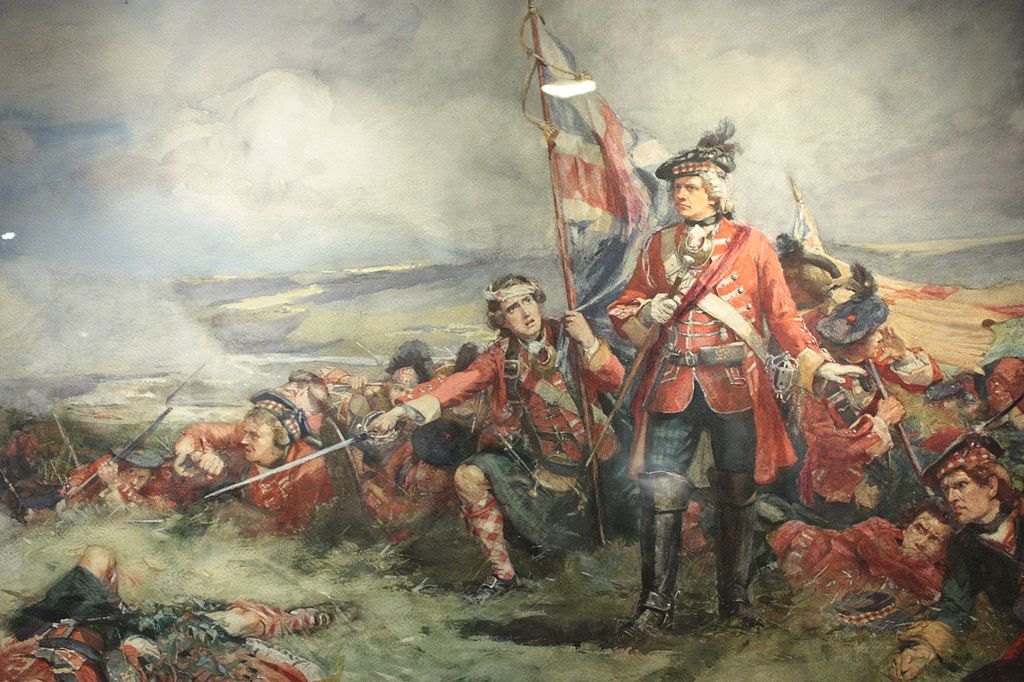
The Black Watch at the Battle of Fontenoy by William
Skeoch Cumming.
The Black Watch Chaplain at the Battle of Fontenoy,
1745 by William Skeoch Cumming (1897)
In March 1743 the regiment was ordered south into England.
They reached London on 29th and 30th April, and in May embarked for the
Continent, to join the army under command of the Earl of Stair at grips with
the French forces of Louis XV. They sailed from Gravesend to Ostend, whence
they marched to Brussels, arriving on 1 June 1743; and thence by Liege to
Hanau, where lay the army commanded by George II in person, who had just
assumed command from the Earl of Stair. Throughout the ensuing twelve months or
more the Highlanders saw no active service, but the year 1745 was to be an
eventful one for the Black Watch and indeed for the regiment’s homeland.
Leading the powerful French forces in the Low Countries was
the redoubtable Marshal Saxe, one of the greatest military figures of the
century. He was opposed, after King George returned to England, by the Duke of
Cumberland, at least the equal of the most unsuccessful general ever to have
commanded British troops. Together with his Dutch allies and some Austrians, he
marched at the beginning of May to relieve the fortress of Tournai from the
siege with which Marshal Saxe had opened his campaign. Leaving a force to
‘mask’ Tournai, Saxe had drawn up his army in a superb defensive position some
miles away. Forming the key point of all’ L-shaped defence line was the village
of Fontenoy; several woods formed natural obstacles, redoubts were constructed
by the French to add to the hazards faced by the attackers, and the whole front
was liberally garnished with field-guns.
On 10th May when, in the manner of the time, the Allied army
began its deliberate approach, it was seen that the planned start line for the
attack could be reached only through the small village of Vezon. A mixed force
of infantry and cavalry, including the Highlanders, was therefore detailed to
clear the place. This was achieved with little trouble, the French falling back
after a sharp exchange of musketry; and that was the Black Watch’s baptism of
fire. Thereafter the regiment was posted on the extreme right of the Allied
line, facing the wood of Barri, which formed the point d’appui of the French
left flank. The following morning the task of clearing the French from the wood
was given to a certain Col. Ingoldsby, who was provided with a brigade
consisting of the 12th and 13th Foot, a Hanoverian regiment, and the
Highlanders. At 6.00 a.m. the brigade moved off, but a succession of quite
inexplicable events halted it. Whether it was uncertainty on Ingoldsby’s part or
confusion resulting from conflicting orders from his superiors, is not known
(he was later acquitted at a court martial) but, despite the arrival of
supporting artillery, he either could not or would not press home the attack.
By 11.00 a.m. a Dutch attack on Fontenoy had failed, and the Highlanders were
ordered to proceed from the right to the left flank to support them in a second
assault. This was much more to their taste; off they went at the double led by
Lieut.-Col. Sir Robert Munro, and stormed forward against the French positions
about Fontenoy with tremendous spirit and elan. The French, protected by field
fortifications and in considerable strength, were much shaken by this unusual
attack launched by Highland furies armed – thanks to the granting of a request
that this day they should fight with their native weapons – with broadsword and
targe. Over the first line of entrenchments poured the Highlanders, but the
French musketry was sustained and deadly and many of them fell and died before
the fortifications. After a bitter struggle the Highlanders had to retreat,
carrying with them the Lieutenant-Colonel, a man of such tremendous girth that
he stuck in one of the entrenchments and barely escaped being made prisoner.
While the Black Watch was regrouping after this onslaught,
there followed the tremendous episode when the solid mass of British and
Hanoverian infantry – 16,000 strong – advanced into the heart of the French
position, shattering the Gardes Francaises and many another distinguished regiment
of the ancien regime, and retiring only after having been .virtually decimated
by musketry and gunfire and innumerable cavalry and infantry counter-attacks.
The Highlanders and another battalion were detailed to cover the inevitable
retreat, a difficult duty even though there was no sustained pursuit, and the
regiment was singled out for special praise by Cumberland in his report of the
battle.
As an additional mark of favour, the men were asked if there were any special requests they might like to make. Unanimously they expressed the desire that two of their comrades, under sentence of flogging for allowing some prisoners to escape, should have the punishment remitted. Another incident is worth recording. On the morning of the battle, when the Highlanders paraded, the commanding officer saw the regimental minister standing in the ranks with drawn broadsword. This was Adam Ferguson, later Professor of Moral Philosophy at the University of Edinburgh, who was threatened upon the spot with the loss of his commission if he did not at once return to his more orthodox duties. ‘Damn my commission!’ retorted the bellicose prelate and marched off to battle with his men. Their first engagement cost the regiment dearly, over 30 officers and men killed and nearly 90 wounded – not as serious as the casualties of some other regiments taking part, but bad enough.